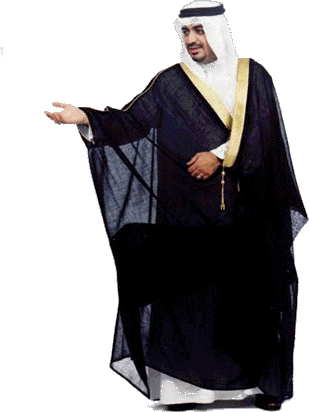
Bisht by Mokhtar Chahine
Article written by Rima Al- Mukhtar
A bisht is a traditional Arabian long cloak men wear over their thobes. This cloak is usually made of wool and ranges in color from white, beige, and cream to the darker shades of brown, grey and black. The word bisht is derived from Persian — to go on one’s back. Originally
the bisht was worn in winter by Bedouins. Now it’s only worn for
special occasions like weddings, festivals, graduations and Eid. The bisht has been the choice of formal wear for politicians, religious scholars and high-ranking individuals in Arabian Gulf countries, Iraq and countries north of Saudi Arabia. This traditional flowing cloak is meant to distinguish those who wear it. People say no cloth can provide the distinction of a hand-tailored bisht. This is why the art of bisht tailoring is a skill handed down from generation to generation.
Abu Salem, a Saudi tailor from Al-Ahsa, said, “Bishts were first tailored in Persia. Saudis were introduced to them when bisht vendors came here for Haj or Umra.”
Al-Ahsa area in the Eastern Province has been home to the best bisht tailors for over 200 years and leading producers in the Gulf countries since the 1940.
Some families in Al-Ahsa inherited their forefather’s skill and continue to make bishts in their family name. You can find a bisht called the Al-Qattan, Al-Kharas, Al-Mahdi or the Al-Bagli.
Three types of embroidery are used in making the bisht: gold stitch, silver stitch and silk stitch. The thread is called zari and gold and silver are very common. “Black bishts with gold stitching is the most popular, after cream and white,” said Abu Salem. “In the early 90s new colors were introduced to the bisht market. Blue, grey and maroon are mostly worn by the younger generation. The older generation sticks to the traditional black, brown and cream,” he added.
Prices vary from SR 100 all the way up to SR 20,000 depending on the fabric, stitching, color and style. The most expensive, the Royal bisht is specially tailored for princes, politicians and the weathy. “These people usually choose black, honey, beige and cream for their bishts,” said Abu Salem. “They are always handmade and use gold or silver thread and sometimes a combination of both,” he added.
Abu Salem said, “There are two kinds of zari, the genuine which is silk or cotton yarn covered with pure gold or silver, and the imitation where the yarn is covered with silver electroplated copper wire. Each tailor has his own trademark zari design.”
There are three main bisht designs, the Darbeyah, Mekasar and the Tarkeeb.
Darbeyah is handmade with genuine zari embroidery and traditional patterns and the style is square and loose. Mekasar also known as Gasbi, has silk embroidery along the edge of the fabric.
“Tarkeeb means fitting and it comes with a Darbeyah design with gold zari embroidery on tailored bisht fabric,” said Abu Salem.
Until the invention of the sewing machine the original bisht was hand sewn. “These days most bishts are machine-made but some people prefer a handmade one for their finer detail,” he said.
Abu Salem said, “Tailoring Hasawi bishts is an art that requires accuracy and skill. The gold embroidery requires patience and takes many hours. The length of time depends on the style and design. Hand-making one of these bishts could take from 80 to 120 hours and four tailors, each with one specific task.”
The Hasawi, a special of Al-Ahsa, is the most expensive using camel or lama hair or goat wool with gold embroidery on the collar and sleeves.
Traditionally, the bisht has two sleeves but it can be worn with only one arm through the sleeve and the other wrapped around loosely and tucked into the side.

Source:
http://www.arabnews.com/fashion/traditional-modern-saudi-mans-bisht
